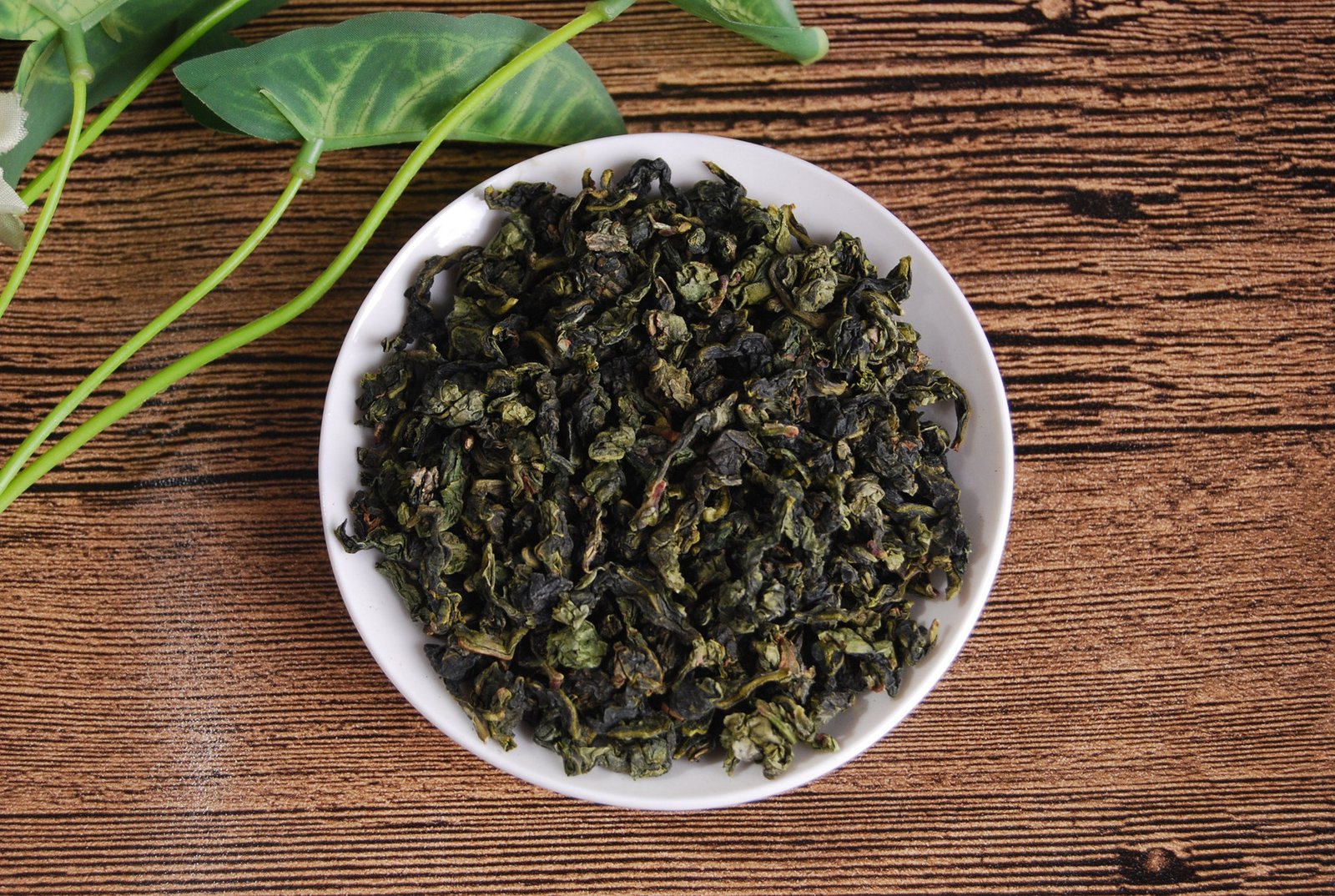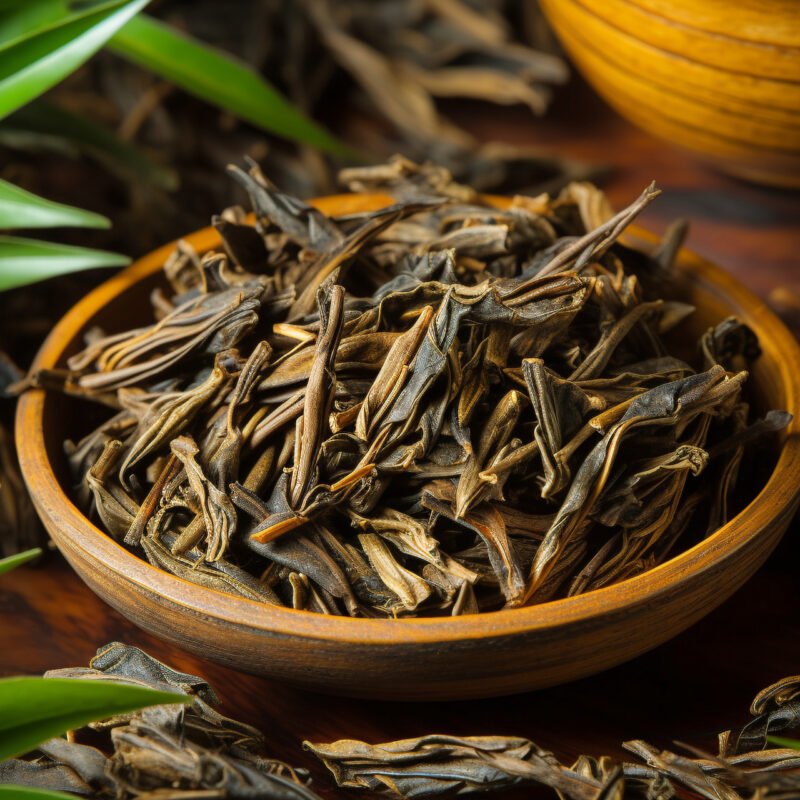
SUN-DRIED BLACK TEA
August 25, 2025
WILD POTHOS TEA
August 25, 2025TIEGUANYIN TEA
$246.80 Original price was: $246.80.$238.90Current price is: $238.90.
Emerging from the rolling, mist – enshrouded hills of Anxi, Fujian, this renowned oolong tea draws life from a region steeped in tea – making history and blessed with a unique terroir. The tea gardens, nestled among the peaks and valleys at elevations ranging from 300 to 1000 meters, are embraced by a subtropical monsoon climate. Abundant rainfall, averaging between 1600 – 1800 millimeters annually, nourishes the soil, while the distinct four – season cycle, with average temperatures of 16 – 21°C, creates an ideal micro – climate for the tender tea bushes to thrive. The soil, a fertile, slightly acidic red loam rich in minerals, provides the perfect foundation for the growth of the Tieguanyin tea variety, whose leaves are characterized by their horizontal growth, elliptical shape, drooping and slightly crooked tips, sparse and blunt serrations on the edges that curl slightly backward, thick, meaty texture, and wavy, prominently ribbed surface.
Exceptional Flavor Profile
Savor the tea’s complex, enchanting essence: a rich, honey – like base with notes of ripe tropical fruits such as mango and lychee, balanced by a pronounced floral aroma, often likened to the sweet, delicate fragrance of orchid blossoms. The first sip delivers a smooth, velvety taste—reminiscent of a warm summer evening in a fragrant garden—with a hint of natural astringency that quickly fades into a long – lasting, sweet finish. A distinct “Guan Yin Yun” (Guanyin rhyme) lingers on the palate, a unique quality that is both grounding and invigorating, making each sip a new discovery. The liquor shimmers with a deep, golden – yellow hue, its texture full – bodied yet refined, carrying the essence of Anxi’s tea – filled landscapes in every drop.
Artisanal Craftsmanship
Harvested in the spring and autumn, when the tender shoots of the Tieguanyin tea variety have reached the perfect stage of maturity, local tea pickers rise before dawn. They painstakingly pluck only the finest two – or three – leaf shoots, ensuring each piece is of the highest quality. The fresh leaves are then gently carried down the mountain in bamboo baskets to the processing workshops. Here, they first undergo a withering process, which may involve a combination of sun – withering and indoor – withering. Sun – withering, typically done in the afternoon when the sunlight is soft, allows the leaves to lose about 6 – 9% of their moisture content, enhancing the activity of various enzymes within the leaves in preparation for the subsequent steps. This is followed by a series of indoor – withering and “zuo qing” (making – green) processes.
The “zuo qing” stage, which involves alternating between gentle shaking (yao qing) and resting (tan qing), is a crucial and highly skilled part of the process. The shaking causes the edges of the leaves to rub against each other, slightly damaging the cells and triggering a slow oxidation process. The resting periods allow the leaves to recover and for the chemical reactions to occur more fully. This process is repeated multiple times, with the intensity and duration of each shaking and resting period carefully adjusted based on the condition of the leaves, the weather, and the desired flavor profile. Skilled tea – makers rely on their experience and keen observation to master the art of “kan qing zuo qing” (making tea according to the condition of the tea leaves) and “kan tian zuo qing” (making tea according to the weather), ensuring that the unique “Guan Yin Yun” and “lan hua xiang” (orchid fragrance) are developed to perfection.
Once the leaves have reached the right state of oxidation, they are pan – fried (chao qing) at a high temperature to halt the enzymatic activity and fix the flavor and color. This is followed by a gentle rolling and shaping process, which helps to release the tea’s natural oils and form its characteristic shape. The leaves then enter a crucial stage of “bao rou” (wrapping and rolling), a unique technique exclusive to Tieguanyin. In this process, the tea leaves are wrapped in cloth and rolled and kneaded repeatedly to further shape the tea into its signature tight, spiral form. Finally, the tea is dried at a low temperature, typically around 60 – 80°C, until it reaches the perfect dryness, locking in its rich, complex aroma. This meticulous process, passed down through generations of skilled tea – makers, results in a tea that is both rich in flavor and full of character.
Classification
Tieguanyin can be classified into several types based on its fermentation level and processing methods:
- Qingxiangxing (Fresh – Aroma Type): This type is characterized by a light fermentation level, usually around 20 – 30%. The tea leaves are greenish – brown in color, and the liquor is light yellow with a fresh, floral aroma. It has a relatively light and refreshing taste, with a hint of sweetness, and is popular among those who prefer a more delicate flavor.
- Nongxiangxing (Rich – Aroma Type): With a higher fermentation level, typically around 40 – 60%, this type has a darker color, often brownish – black. The liquor is golden – yellow to amber, and it exudes a more intense, complex aroma that combines floral, fruity, and roasted notes. The taste is more robust and full – bodied, with a long – lasting aftertaste, appealing to those who enjoy a more concentrated and flavorful tea.
- Chenxiangxing (Aged – Aroma Type): Also known as old tea or matured tea, this type is made from either Qingxiangxing or Nongxiangxing Tieguanyin that has been stored for an extended period, usually several years. The aging process gives the tea a unique, mellow flavor and a smooth, velvety texture. The color of the liquor is deep, often a dark red – brown, and it has a warm, earthy aroma with hints of dried fruits and aged wood.
- Tanbei Tieguanyin (Char – Roasted Tieguanyin): On the basis of traditional semi – fermented Tieguanyin, this type undergoes an additional charcoal – roasting process for about 5 – 7 hours. The roasting imparts a distinct, smoky – roasted flavor to the tea. The 汤色 (liquor color) is deep yellow, and it has a strong, long – lasting aftertaste, with a unique sensation that leaves the throat feeling particularly smooth and comfortable.
Health Benefits
Tieguanyin is not only a delight to the taste buds but also offers several potential health benefits:
- Antioxidant Properties: Rich in polyphenols, especially catechins like epigallocatechin – 3 – gallate (EGCG), Tieguanyin helps to combat free radicals in the body, reducing oxidative stress and potentially slowing down the aging process.
- Heart Health: The tea may contribute to heart health by helping to lower cholesterol levels, reducing blood pressure, and improving blood vessel function. The polyphenols and caffeine in Tieguanyin can help to dilate blood vessels, decrease blood vessel resistance, and thus promote better blood circulation.
- Digestive Aid: It can aid digestion by stimulating the secretion of digestive enzymes, helping to break down food more efficiently. This can be particularly beneficial after a heavy meal, as it may help to relieve feelings of fullness and indigestion.
- Weight Management: Some studies suggest that the components in Tieguanyin, such as caffeine and certain polyphenols, may boost metabolism and increase fat oxidation, potentially assisting in weight management efforts.
- Oral Health: The antibacterial properties of the tea may help to inhibit the growth of bacteria in the mouth, reducing the risk of dental caries and bad breath. Regular consumption of Tieguanyin may contribute to better oral hygiene.
Brewing Guidelines
- Water Temperature: Use boiling water, around 100°C (212°F), to fully extract the flavors of Tieguanyin. However, for the more delicate Qingxiangxing type, slightly lower temperatures, around 90 – 95°C (194 – 203°F), can be used to prevent over – extraction and preserve the tea’s fresh, floral notes.
- Steep Time: For the first infusion, steep the tea for about 1 – 2 minutes. Subsequent infusions can be gradually lengthened by about 30 seconds to 1 minute each, depending on personal taste preferences. Tieguanyin is known for its ability to withstand multiple infusions, often retaining its flavor for up to 6 – 7 times.
- Ratio: Use approximately 5 – 7 grams of dried tea leaves per 150 – 200 milliliters of water. This ratio can be adjusted according to personal taste, with more leaves resulting in a stronger, more concentrated flavor.
- Teapot Selection: Opt for a small, clay or porcelain teapot, as they can help to retain the tea’s heat and enhance its flavor. Porcelain teapots are particularly good for highlighting the clarity and color of the liquor, while clay teapots can add a certain warmth and smoothness to the taste.
Packaged in a sealed, air – tight container, preferably a tin or a ceramic jar, Tieguanyin can be stored in a cool, dry place away from direct sunlight and strong odors to preserve its freshness and flavor for an extended period. Let each sip transport you to the idyllic tea gardens of Anxi—where this exceptional tea captures the essence of centuries – old tea – making traditions, the bountiful gifts of nature, and the unwavering dedication of generations of tea – makers.
Category: OOLONG TEA
| Weight | 0.1 kg |
|---|
Store
Price
Details
WILD TEA TRADE
0 out of 5
0 out of 5
0 out of 5
0 out of 5
0 out of 5
0 out of 5
0 out of 5
General Inquiries
There are no inquiries yet.
Related products
-
ZHENGYAN CINNAMON TEA
$158.80Original price was: $158.80.$149.80Current price is: $149.80.0 out of 5








